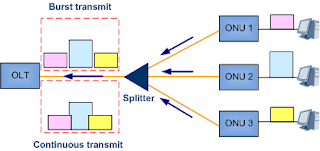In 10G GPON upstream direction, Time Division Multiple Access
(TDMA) is used. An optical network unit (ONU) transmits data only within the
allocated timeslots. In the timeslots that are not allocated to it, the ONU
disables the transmission of its optical transceiver to prevent other ONUs from
being affected. The optical line terminal (OLT) then receives the upstream data
from each ONU in a burst manner based on timeslots. Therefore, to ensure normal
running of the 10G GPON system.
- Figure 1 shows the burst transmit function supported by ONU-side optical modules.
- Figure 2 shows the burst receive function supported by OLT-side optical modules.
- The distance from each ONU to the OLT varies and therefore the optical signal attenuation varies for each ONU. As a result, the power and level of packets received by an OLT at different timeslots various.
- If the OLT-side optical modules do not support the burst receive function, the OLT may restore incorrect signals because only the level greater than the threshold is considered valid and the signals with the level lower than the threshold cannot be restored.
In the 10G GPON system, all data is broadcast downstream to ONUs. The
transmission requires OLT-side optical modules to transmit optical signals
continuously and ONU-side optical modules to receive optical signals
continuously. Therefore, these optical modules are not required to support the
burst receive and transmit function.
More related:
More related:


No comments:
Post a Comment